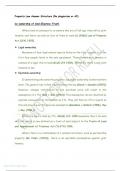Lecture notes
Property Law Notes and Answer Structure UOL LLB (No plagiarism/AI)
- Module
- Property Law (LA2003)
- Institution
- Birkbeck, University Of London (BBK)
These are my property law notes and answer structure that I use in UOL LLB exams, they are free of plagiarism and has no traces of AI like ChatGPT.
[Show more]



